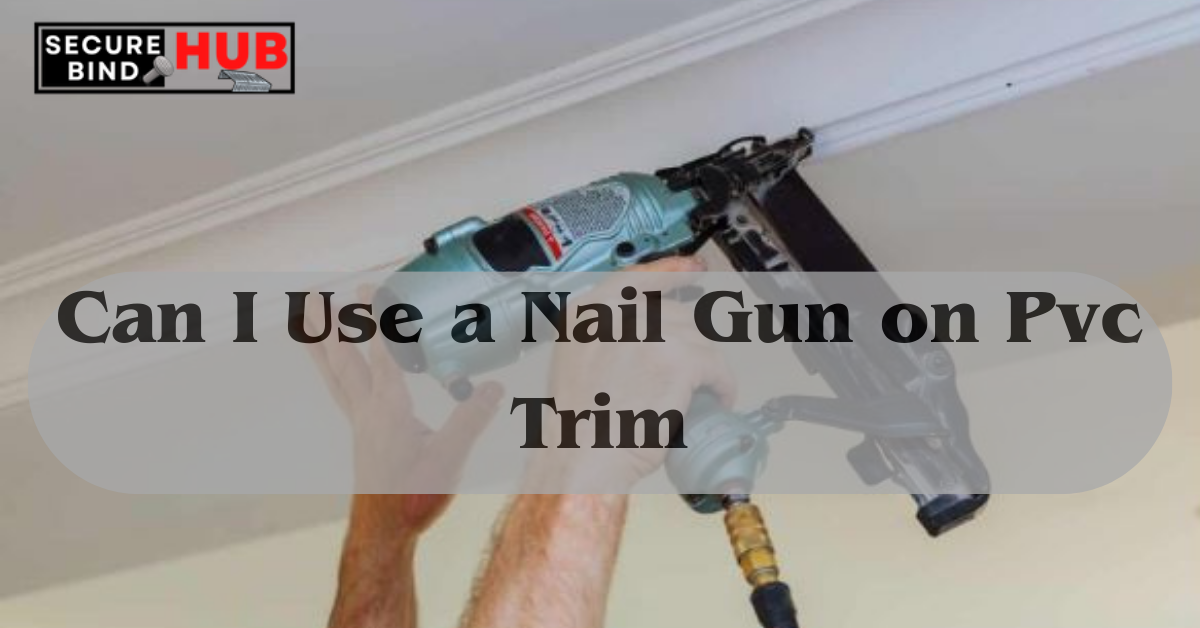When it comes to PVC trim installation, using the right tools is crucial for achieving a professional and durable finish. Many homeowners and DIY enthusiasts often wonder whether they can use a nail gun on PVC trim. The answer is both yes and no, depending on the right techniques and precautions. In this comprehensive guide, we’ll walk you through the process, providing expert tips and advice to ensure a successful PVC trim installation while preserving the integrity of the material.
Can I Use a Nail Gun on PVC Trim?

Absolutely, you can use a nail gun on PVC trim, but there are important considerations to keep in mind. PVC trim is a versatile and durable material that’s commonly used for exterior applications due to its resistance to moisture, insects, and rot. However, PVC trim has different characteristics compared to wood, which means you’ll need to adjust your nail gun settings and techniques accordingly.
Adjusting Nail Gun Settings
To use a nail gun on PVC trim, start by adjusting the tool’s settings. PVC is a relatively soft material compared to wood, so you’ll need to reduce the nail gun’s air pressure and depth settings to avoid over-penetration. Set the pressure to a lower level and adjust the depth so that the nails are flush with the surface of the PVC trim.
Choosing the Right Nails
Selecting the appropriate nails is crucial for a successful PVC trim installation. Opt for stainless steel or galvanized nails that are specifically designed for outdoor use. These nails are resistant to rust and corrosion, ensuring that your PVC trim remains securely fastened over time.
Using a Nail Gun Sparingly
While it’s possible to use a nail gun on PVC trim, it’s important not to overdo it. PVC trim expands and contracts with temperature changes, so using too many nails in a small area can lead to cracking. Instead, space the nails adequately to allow for movement without compromising the material.
Pre-drilling Holes
To further prevent cracking, consider pre-drilling holes for the nails. While PVC trim is less likely to split compared to wood, pre-drilling ensures a clean entry point for the nails and reduces the risk of any stress-related damage.
Key Steps for Using a Nail Gun on PVC Trim

Using a nail gun on PVC trim involves several key steps that contribute to a successful installation. Let’s delve into these steps to help you achieve the best results.
Measure and Cut: Begin by measuring and cutting your PVC trim to the desired length using a saw that’s suitable for PVC materials.
Prep the Surface: Ensure the surface where you’ll be installing the trim is clean and free from debris. This promotes proper adhesion and reduces the risk of moisture-related issues.
Nail Gun Selection: Choose a nail gun that allows you to adjust the air pressure and depth settings for precise nail placement.
Adjust Settings: As mentioned earlier, adjust the nail gun settings to accommodate the softer nature of PVC trim.
Test Nailing: Before proceeding with the full installation, perform a test nailing on a scrap piece of PVC trim to confirm that the nail depth is appropriate.
Spacing and Placement: Plan the spacing and placement of nails, ensuring they’re evenly distributed and appropriately spaced to prevent cracking.
Pre-Drill Holes: For added protection against splitting, pre-drill holes at the nail locations using a drill bit slightly smaller than the nail diameter.
Install the Trim: With the preparation complete, use the nail gun to secure the PVC trim in place, making sure to follow the spacing and placement plan.
Finishing Touches: Once the trim is installed, fill any nail holes with PVC trim adhesive or putty, and sand the surface for a smooth finish.
Frequently Asked Questions
Will using a nail gun damage my PVC trim?
If used correctly, a nail gun shouldn’t damage your PVC trim. Follow the recommended settings and techniques to avoid over-penetration.
Can I use regular nails for PVC trim?
It’s recommended to use stainless steel or galvanized nails designed for outdoor use to prevent rust and corrosion.
How do I prevent cracking around the nails?
Proper spacing, pre-drilling holes, and using the right nail gun settings can help prevent cracking in PVC trim.
Can I paint PVC trim after nailing?
Yes, you can paint PVC trim after nailing, but make sure to use paint that’s specifically formulated for PVC materials.
Can I use a nail gun in cold weather?
Cold weather can make PVC trim more brittle, so exercise caution and consider pre-drilling holes to prevent cracking.
How do I remove a nail from PVC trim?
Gently pry the nail using a flat-head screwdriver, taking care not to damage the surrounding trim.
Conclusion
Using a nail gun on PVC trim is indeed possible, provided you take the necessary precautions and follow the recommended techniques. Remember to adjust the nail gun settings, choose the right nails, and space them appropriately to ensure a successful installation without compromising the integrity of the PVC material. By adhering to the professional guidance provided in this manual, you’ll attain a secure and enduring PVC trim installation that elevates both the aesthetics and resilience of your undertaking.

